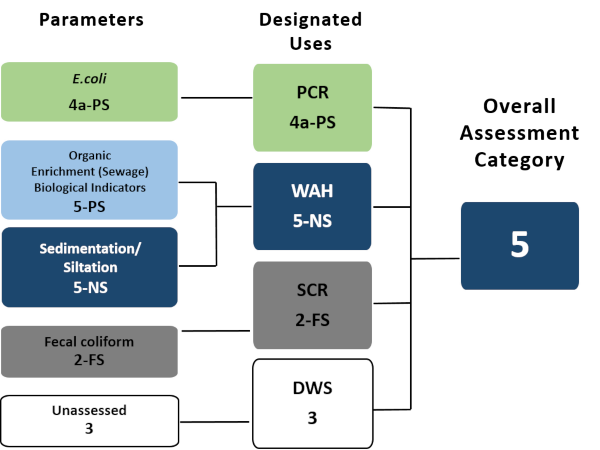Attainment
When water quality sampling occurs, specific information is gathered for each
 designated use. The data collected are compared to water quality standards to determine attainment, or support, of the designated use.
designated use. The data collected are compared to water quality standards to determine attainment, or support, of the designated use.
For example, bacteria levels are examined when determining if the primary contact recreation (PCR) designated use is being supported, while water chemistry, habitat, and biological communities are examined when determining if aquatic life (WAH or CAH) designated use is being supported.
If water quality standards are being met, then the attainment of that designated use is Full Support (FS). If water quality standards are not being met, then the attainment of that designated use is Partial Support (PS) or Nonsupport (NS). Waterbodies classified as PS or NS for one or more of its designated uses due to either a pollution or a pollutant are considered impaired.
Surface Water Assessment Categories
The 305(b) list is a list of all waterbodies that have been assessed for one or more designated uses. Waterbodies on the 305(b) list are put into different categories depending upon the assessment decision made for that waterbody (Table 1). Impaired waterbodies on the 305(b) list will belong to category 4a, 4b, 4c or 5 (Table 1).
Table 1. Surface Water Assessment Categories
| 1 | EPA | All designated uses for waterbody are Fully Supporting |
| 2 | EPA | Assessed designated use(s) is/are Fully Supporting, but not all designated uses assessed |
| 2b | KY only | Segment currently supporting use(s), but 303(d) listed and proposed to EPA for delisting |
| 2c | KY only | Segment with an EPA approved or established TMDL for use(s) now attaining Full Support |
| 3 | EPA | Designated use(s) has/have not been assessed (insufficient or no data) |
| 4a | EPA | Segment with an EPA approved or established TMDL for listed use(s) not attaining Full Support |
| 4b | EPA | Nonsupport segment with an approved alternative pollution control plan (e.g. BMP) stringent enough to meet full support level of all uses within a specified time |
| 4c | KY only | Segment does not support designated use(s), but this is not attributable to a pollutant or combination of pollutants |
| 5 | EPA | Segment does not support designated use(s) and is impaired by a pollutant or combination of pollutants. A TMDL is required |
Categories are assigned on multiple levels.
A waterbody's overall assessment category is determined by the designated use category which is determined by the parameter level category (Figure 1).

Figure 1: Schematic diagram of how surface water assessment categories at the parameter and designated use level determine the overall surface water assessment category for a hypothetical waterbody in Kentucky
Figure 1 illustrates a hypothetical waterbody in Kentucky that has been assessed. This waterbody has been assessed for more than one designated use — primary contact recreation (PCR), warm water aquatic habitat (WAH), and secondary contact recreation (SCR). The designated use, domestic water supply (DWS), has not been assessed for this waterbody.
In Figure 1, the overall assessment category is category 5 because the waterbody is impaired by at least one pollutant where a TMDL has not yet been developed. The overall surface water assessment category is determined by the most impaired designated use scenario, which in Figure 1 is the WAH designated use, category 5-NS. This waterbody is not attaining (i.e. not supporting) the WAH designated use because it is impaired by two pollutants which still require a TMDL.
The designated use category determinations are based on the parameters assessed. If more than one parameter has been assessed for a designated use, the designated use assessment category is determined by the most impaired parameter scenario. In Figure 1, the WAH designated use has been assessed for Organic Enrichment (Sewage) Biological Indicators and Sedimentation/Siltation. Water quality standards are not being met for these parameters and a TMDL is required to address both pollutants. The most impaired parameter scenario is Sedimentation/Siltation, category 5-NS. Parameters classified as NS are more impaired than parameters classified as PS.
The other two assessed designated uses were assessed for only one parameter so the PCR designated use is determined by the
E.coli parameter (category 4a-PS) and the SCR designated use is determined by the fecal coliform parameter (category 2-FS).
To find the surface water assessment categories assigned to assessed waterbodies in Kentucky, refer to the most recent  305(b) List.
305(b) List.
For more information about Kentucky's assessment and listing methodology including information clarifying the distinction between partial support and nonsupport, refer to the  Consolidated Assessment and Listing Methodology (CALM).
Consolidated Assessment and Listing Methodology (CALM).
Re-categorization
A waterbody that has been assessed and assigned to a surface water assessment category can be re-categorized. Find out more in this  Re-categorization Example [PDF, 232 KB].
Re-categorization Example [PDF, 232 KB].
303(d) List -- Category 5 Only
The 303(d) list is a subset of the 305(b) list and only includes those waterbodies in category 5, which require a TMDL.
The waterbodies on the 303(d) list:
Have been identified as having one or more parameters that are not meeting water quality standards, which impairs the designated use
The parameter of impairment is a pollutant (not pollution)
Require the development of a
 TMDL
TMDL
Each row on the 303(d) list is called a pollutant-waterbody combination (PWC). Each PWC consists of a waterbody that is not meeting water quality standards for a specific parameter (identified as a pollutant), which results in the impairment of one or more designated uses.. A waterbody will have one entry on the 303(d) list for each parameter causing an impairment.